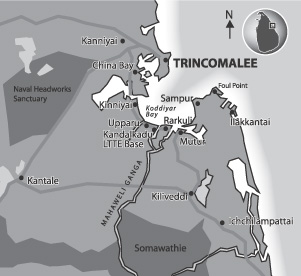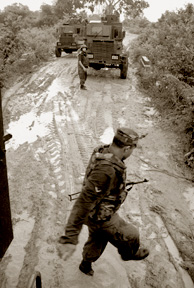|
observer |
|
|
|
|
|
OTHER LINKS |

|

|

|
Manirasakulam, Rarkuli,Upparu and Sampur:Military gains which went obscure
Manirasakulam is a long and strange story. It is about how the LTTE exploited the ceasefire agreement - which prevented the two signatories from engaging in offensive operations- by expanding its military build up, knowing well that the ceasefire agreement would discourage the counter actions by the security forces. It is also a sorry story of how the previous Administrations, over optimistic of the prospects of peace, turned a blind eye as national security was threatened. Hence this sorry state of affairs aggravated exploited the situation. President Chandrika Kumaratunga took over three ministers including Defence, citing the threat to the national security as one reason. But throughout there appeared lack of political will to counter the threat posed by the LTTE military build up in the Southern perimeter of the Trincomalee harbour, which is the life line of 42,000 soldiers and policemen deployed in the jaffna Peninsula.
Amidst retorics by the Tiger leadership and the absence of political will for counter military actions by the Wickremesinghe and the Kumaratunga Administrations, the stalemate continued for the next three years. Original intentionsIf the past administration followed this flawed which is contrary to its original intentions strengthen the Tigers - the present administration has shown a marked departure. The Rajapaksa Administration captured Sampur, an Tiger enclave in the Southern perimeters of the Trincomalee harbour, then captured the Manirasakulam, Rarkuli,Gangee and Upparu in the west of Mutur. It was an operation which proved the exemplary jungle warfare In the first week of the October, following the success in Sampur, the security forces received the political green light to capture the jungle terrain in the South of Trincomalee. Special force commandos operating in small groups trekked in to the jungles. They engaged in reconnaissance missions for days and fed the operational commanders of the enemy build up and their movements. They pinpointed enemy targets for the artillery and Multi barrel Rocket Launchers strikes. After a week of reconnaissance missions, on Saturday night, October 07, Special Commandoes moved in to the jungle camps of the LTTE. In Manirasakulam, the tigers initially moved their camp deep in to the jungle, unable to face the mounting barrage of MBRL attack. Then their new positions came under the artillery fire. LTTE was taken by surprise. By the dawn of Sunday, the Tigers vacated their positions and withdrew deep in to the jungles. I visited Manirasakulam this week where a new military camp is set up by the 7 Ceylon Light Infantry (CLI). Soldiers were digging trenches while some others building makeshift huts. As heavy rains lashed, soldiers had few shelters to seek cover. Just as the capturing an area, holding it the under trying circumstances is a tedious task. The extreme weather of the North-Eastern monsoon is making it harder. But, they won't relent, indeed, they can not afford to be so. Their service to the nation remains in obscurity in most of the time, as well as their achievements like how they fought in the jungles in the east. They are the unsung heroes who risked their lives and limp, yet whose sacrifices are little known, perhaps only to their colleagues. Rarkuli and Upparu, South of Trincomalee were an LTTE stronghold. Kandalkadu deep into the jungles, on the bank of the Mahaveli river was a sea Tiger training base. Taken by surpriseBut the Tigers were taken by surprise as artillery and MBRL barrage pounded on their targets, based on intelligence provided by the SF commandos engaged in reconnaissance missions. The Tigers could offer little resistance as troops moved deep into the enemy bases on Saturday night. In the face of artillery and MBRL attacks, the Tigers fled the area. Targets were precise. The remnants of a building, believed to be used as the conference hall of the sea Tigers could be seen. According to military officials, the camp could have accommodated about 100 cadres. The Kandalkadu sea Tiger base had been located taking the maximum advantage of the geography of the jungle terrain. The camp is surrounded by the jungles and heavy tree canopy guarded it from the Unmanned Areal Vehicles (UAV) and air attacks. Sea tigers used the river as well as the road link from Muttur as supply routes. There is a large open area which is used as the parade ground of the training camp. Next to it is a cemetery of the fallen LTTE cadres. There were six freshly dug graves whose name boards read as they were killed on August 2, during the Tiger attack at the Kattaparichchan army camp and the Mutur naval detachment. One officer said the LTTE recruits had played cricket in the open area pointing to a few stumps and a makeshift cricket bat on the ground. The capture of Upparu, over looking the Koddiyar bay is of vital to the security of the Trincomalee harbour. Following the collapse of its eastern enclave, Sampur, from there the 122 mm artillery attacks were mounted by the LTTE on the China bay naval base, there were concerns that the Tigers would shift their camps to Upparu. However, with the fall of Sampur, the LTTE found its hold in Upparu is fragile. Sea supply route was cut off with the increasing naval presence in the Koddiyar Bay. All this compelled the LTTE retreat from Upparu, Gangee and Rarkuli- Gangee on the river bank of Uppu Aru also saw an increasing LTTE activity. Upparu is now a large swath of jungle. But, five decades ago, it was known for tobacco cultivation. There was a sizable Muslim population co-habiting with Tamils in the area before the broke up of the ethnic conflict. Things have fallen apart since then. People fled their farmlands. It is now a desolate land, crept by a thick jungle. Naval detachment and an army camp have now been set up to keep away the Tiger infiltrators. Rarkuli is a village and its inhabitants, mainly fisher folks had fled the village as Tigers launched the simultaneous attacks on Mutur navy detachment and, Kattaparichchan, Selvanagar and Mahinda army camps. Now the village is abandoned, its houses uninhabited. Their inhabitants are believed to have fled to Kathiraveli and Vakarai.
This and repeated attempts by the Black tiger suicide boats to target naval gunboats and security personnel carriers underscored the threat posed by the LTTE build up in Sampur. Finally, in mid August, green light was given for the capture of Sampur, the eastern Tiger enclave where located several sea tiger bases. Sampur was important to the Tigers in both military and political perspectives. Fourteen LTTE camps were set up in the Southern perimeter of the Trincomalee harbour, most of them in the general area of Sampur, which is about 160 square km in size. Major launching padTwo major sea Tiger bases, Illakkanthai and Soodaikudai on the west of Foul point were based in Sampur. Illakkanthai was earlier the major launching pad of the sea Tigers. Later, Soodaikudai was used as the launching pad for suicide operations due to its location in the mouth of the harbour. Soodaikudai was the launching pad for the Sea Tiger boats which embarked on the abortive attack on the security personnel carrier, Jet Liner transporting 840 odd troops. The security forces believed that the Tigers had positioned at least three 122 mm artillery guns in the general area of Sampur. Another artillery gun was believed to have placed in Ichchalampattu, south of Sampur. As far as political aspects are concerned Sampur was home to LTTE political headquarters in the Trincomalee district. LTTE Trincomalee political chief Elilan operated from Sampur. So did Tiger 'military leader' in Trincomalee "Colonel" Soornam. Jungle warfareThe capture of Sampur is again an exemplary show of jungle warfare. The SF commandos sneaked into the jungles of Sampur. They fed the operational headquarters of the LTTE build up in Sampur and gave corrections for artillery and MBRL attacks. Attacks carried out based on their intelligence proved to be extremely precise as it is evident in the shell hit ruins of LTTE installations. SF commandoes attacked the supply vehicles and disrupted the supply and admin routes of the LTTE. LTTE convoys were caught in claymore blasts. LTTE communication towers were destroyed. A canter truck transporting Tiger cadres to the front exploded in a claymore attack. All that took the Tigers by surprise. Unable to find the unseen enemy, the Tigers turned on some civilians whom they suspected of collaborating with the security forces. Having disrupted enemy military machinery by a classic work of sabotage by the SF commandoes and softened enemy targets through artillery and air strikes, infantry troops moved in on August 28. Troops moved in two directions. At the dawn of the day, 8 Sinha Regiment and 6 Vijayaba Infantry Regiment, flanked by the Special Force moved towards Sampur. One battalion advanced via Galkanda. Fighting broke out as troop moved just a few hundred meters at the 64 mile post, where the Tigers had set up several front line bunkers. After a fierce battle, the bunkers were neutralised. In the other front, troops fought the Tigers guarding the entrance to Tiger controlled area at the other end of the Kattaparichchan bridge. Tank and MBRL fire was directed at the Tiger positions. Then as artillery pounded LTTE positioned at the other end, a six man team of SF commandoes crossed the bridge and executed a lightening assault on the Tiger bunker. On the other end, as the troops advanced from Kattaparichchan, there was a river crossing. Troops prepared a makeshift bridge, having tied empty barrels together. Three companies cross the "bridge," under the cover of the darkness. As the soldiers of the fourth company were crossing it, the barrels loosened, the bridge dismantled. Some fell in to the river, some were desperately holding to the barrels. The noise alerted the Tigers. A burst of Machine gun and T 56 fire directed at the troops from two sides. It was only then that it emerged, soldiers were crossing the river between two bunkers of the LTTE. Troops fought back. By the time the two tiger bunkers were neutralised, five soldiers were killed and 30 wounded in the deadly confrontation. From there, they pushed towards Sampur amidst sporadic resistance from the Tigers. By the time, the troops crossed the river, Tigers were planning their withdrawal. They had been moving their artillery for days, expecting an imminent collapse of Sampur. By the evening, the troops took control of Sampur village. The Tigers vacated its positions as troops moved in. By September 4, security forces were in full control of the former LTTE stronghold of Sampur. This writer visited Illankanthai this week, which was the main launching pad of the sea Tiger vessels. The geography of the terrain and rocks surrounding it had provided a perfect cover for the sea Tiger base, where now functions a naval detachment. However, as it emerges now with the ruins of the Tiger military installations in Sampur, it is obvious that the initial reports and LTTE pronouncement are an exaggeration of the real strength of the LTTE. There are ruins of makeshift buildings in the Illakkanthai sea tiger base and not much fortified sand bag bunkers. A crater caused by aerial bombing is in the middle of the camp. The security forces cut off all supply routs for the Tigers leaving one route for their escape. As the troops advanced, the Tigers fled to Vakarai and Verugal. By the time troops took control of Sampur, it was a ghost town. Civilians had began fleeing the town since the LTTE attack on the Kattaparichchan army camp. Needless to say that locals, most of them were the Tiger sympathisers had prior knowledge of the simultaneous attacks on four security forces camps and they planned their early exit, knowing that the Sampur from where the Tigers embarked on the attack would be targeted in the battle. Sampur had been a model village of the "Eelam" dream. Most inhabitants of the village were the 'Mahaeerar' families, whose members have died fighting for the LTTE's cause. Most houses there are of the exact model of the houses donated to the 'Mahaveerar' families by the LTTE. There are other "tsunami houses" also built by the TRO and other International NGOs. One military official said some houses of the Mahaveerar families did not have kitchens and were fed by the nearest LTTE camps. Almost all the houses had one distinctive similarity. They had trenches built in the garden and a wooden model of T-56 Assault rifle was found in almost every house, abandoned by their inhabitants. The building of a rudimentary mental clinic named after the Tileepan and run by the LTTE is spared in the fighting. Given the form of security operation, houses were also spared of heavy bombardment. But, other issues hinder the resettlement of the civilians who now languish in the LTTE controlled Vakarai. Security forces clearing the area had found three gunny bags of caps, estimated to be 3000 in numbers, removed from anti personnel mines ( Jonny battas), meaning they have been buried by the Tigers during the security forces operation to hinder the security forces's advancement. Over seven hundred anti personnel mines had been recovered from the general area of Sampur since its capture last month. If the resettlement is allowed before the completion of mine clearing, that could pose a greave threat to the civilians. One senior military official recalled the Jaffna experience where even after a substantial mine clearing, many dozens of civilians fell pray to landmines after resetting in the aftermath of the Operation Riviresa. In the heart of the town, lies a sea tiger monument. It depicts a boat in a heavy tide. A few hundred meters to it, there had been a well maintained LTTE cemetery. One security official said troops met an old lady abandoned by her sons. When she was discovered, she was carrying a photograph of Prabhakaran. She called him "Ishwara," a Tamil God. She complained of hunger and said she did not have a meal for two days. Troops feed her with their ration packets. Then directed her to a local refugee camp. Troops came across another family. The old man, a fisherman had lost his leg, attacked by a Maduwa. His wife did not leave him while the rest of the family fled the village. Soldiers went there when they saw a smoke coming from the house. The old couple had prepared a milk rice for the breakfast. They were unimpressed with the LTTE and wanted an exit from the village. Troops referred them to a house of senior citizens. They also made sure that their offsprings would be informed of the new residence of the old couple. |

 The security forces came to know about the LTTE camp in Manirasakulam
on June 16, 2003. This followed the issue of the LTTE build up in the
South of Trincomalee being highlighted at the security Council Meetings.
The Scandinavian truce monitors were informed of the LTTE camp. The SLMM
later ruled the LTTE camp as a violation of the ceasefire agreement and
demanded its removal. The ruling was rejected by the Tigers who
maintained the camp was in existence before the signing of the truce
agreement. The Tigers also warned to retaliate for military action
against the LTTE camp.
The security forces came to know about the LTTE camp in Manirasakulam
on June 16, 2003. This followed the issue of the LTTE build up in the
South of Trincomalee being highlighted at the security Council Meetings.
The Scandinavian truce monitors were informed of the LTTE camp. The SLMM
later ruled the LTTE camp as a violation of the ceasefire agreement and
demanded its removal. The ruling was rejected by the Tigers who
maintained the camp was in existence before the signing of the truce
agreement. The Tigers also warned to retaliate for military action
against the LTTE camp.  The LTTE build up in the southern perimeters of the Trincomalee
harbour had been a cause for concern for the security establishment. The
main form of threat originated from Sampur where the LTTE had positioned
its 122 artillery guns and heavy mortars. The LTTE on several occasions
targeted the Trincomalee harbour with artillery guns. In one occasion on
August 1, six sailors were killed in an artillery attack on the China
Bay Naval Base.
The LTTE build up in the southern perimeters of the Trincomalee
harbour had been a cause for concern for the security establishment. The
main form of threat originated from Sampur where the LTTE had positioned
its 122 artillery guns and heavy mortars. The LTTE on several occasions
targeted the Trincomalee harbour with artillery guns. In one occasion on
August 1, six sailors were killed in an artillery attack on the China
Bay Naval Base. 







